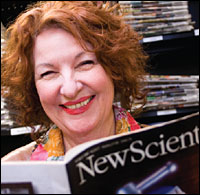Next: Life off the grid
Posted Jan. 11/07
Kathryn O’Hara has a picture she drew in Grade 4 framed in her office. In it, she is looking through a telescope at an observatory on Mount Palomar. That she didn’t place herself in the observatory is prophetic since O’Hara, as the CTV Chair in Science Broadcast Journalism, examines science from the outside.

- When seasoned broadcast journalist Kathryn O’Hara decided to pursue science journalism, she went back to school, earning her MSc in science communication. (Photo: Chris Strangemore)
“Journalists don’t need to understand science at a level of detail where we can reproduce experiments. We need to understand how to communicate the importance of findings or innovations to the general public, and take a critical look at the issues,” says O’Hara.
To do so takes a level of journalistic sophistication that O’Hara is fostering in students in the School of Journalism and Communication. Through a senior science reporting course, journalists become familiar with scientific culture, research evaluation and the popularization of science.
“There was a time when a press release from a drug company would be taken at face value and reprinted. That doesn’t happen as often,” says O’Hara. “Journalists are looking at the source of a story, at financing and potential conflicts of interest, and whether the work is preliminary. The result of better training in science and medical journalism means we see cogent science stories in mainstream media.”
Given the power of the media over public perceptions, it’s important to get it right. A survey conducted by researchers in the School of Journalism, Media and Cultural Studies at Cardiff University in Wales found that more than half the British public wrongly believed that medical science was divided about the safety of the measles, mumps and rubella vaccine because, in coverage of links between the vaccine and autism, both sides of the debate received equal media coverage.
That led 53 per cent of people surveyed to think there must be equal evidence for each side when in fact almost all scientific experts reject the claim of a link.
“The notion of balance is different in science journalism than in other types of reporting where you want to present two sides of a story,” says O’Hara. “Scientific consensus is reached based on conclusive evidence, so the opinions of few shouldn’t be equally weighted against the opinions of the majority.”
That struggle to find the right balance can be seen in stories on climate change and global warming, topics that regularly appear in Canadian media. O’Hara expects the health effects of environmental change to begin making more headlines as smog alerts in urban areas increase, water is contaminated after severe weather causes flooding, and viruses like West Nile thrive in new climates.
“Stories in Canadian media tend to address discoveries, while in Britain, science stories are more likely to tackle the issues,” says O’Hara. “There are issues moving into the political arena in Canada that we’ll start to see getting more coverage, like stem cell research, reproductive technology and the long-term health effects of nanotechnology.”
“Before people can get to a debate about what these topics might mean as an expression of humanity, they have to get the facts straight. Public debates need to take into account the evidence and our values as a 21st century society.”
—
Fast fact…
The CTV Chair in Science Broadcast Journalism was an initiative led by former CTV executive vice-president Trina McQueen, BJ/64. Both Carleton and Laval universities will be the first in Canada to offer courses and eventually programs dedicated to science journalism. Academic excellence and practical values in science journalism will guide the development of the customized curriculum in the School of Journalism and Communication.